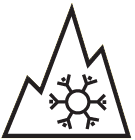Snow tire


Snow tires (winter tires) are tires designed for use in winter conditions, such as snow and ice.[1] They are an alternative to the use of snow chains.
Snow tires are usually tires with a different rubber composition from all-weather tires. Cold-weather tires include a greater percentage of natural rubber and silica so there is not as much hardening as found in synthetic rubber in cold conditions:[2] they provide better traction at lower temperatures. Snow tires provide more small-tread areas, increasing traction on snow and, in wet conditions, allowing water to escape from under the tire more easily. This reduces the risk of hydroplaning. In much of Scandinavia, snow tires have metal studs to improve grip on packed snow or ice, but such tires are prohibited in most other countries for the damage they cause to the road surface.[3] Snow tires do not eliminate skidding on ice and snow, but they greatly reduce the risk.
Regional symbols and rules


North America
In the United States and Canada, a "snowflake on a mountain" symbol means that the tire has exceeded the industry requirement for a reference (non-snow) tire.
Europe
In Europe, requirements for snow tires vary by country: in Austria, Estonia, Finland, Germany, Norway, Romania, Slovenia and Sweden, the use of snow tires is a legal requirement during winter months (usually November to mid-April) or if snow or slush is present on road surfaces: failure to comply can result in on-the-spot fines from the police. Andorra, Italy and Switzerland all recommend snow tires but do not require them. Snow chains fitted to tires are required in Andorra, Austria, France, Germany, Italy, Norway and Switzerland in certain winter conditions.[4][citation needed]
Although there is no legal requirement to use winter tires, drivers in the United Kingdom are encouraged to use them by motoring organisations such as the AA, following the adverse winter weather conditions of 2010.[5] Conversely, the same drivers were discouraged from using winter tires by car insurance companies who, owing to a failure to understand the safety benefits, reportedly charged higher premiums to drivers who fit winter tires. This has since been clarified as incorrect practice by the Association of British Insurers (ABI).[6]
Since July 2008, the Czech Republic uses the Europe-wide road sign requiring the use of snow tires in marked mountainous areas during winter. The duration of obligatory snow tire use was originally November – April (Ordinance 208/2008 Sb.). This was later changed to November – March (Ord. 91/2009 Sb.).
References
- ^ "Winter Tires Lauded For Ice, Snow Safety". CBS News. 12 February 2007.
- ^ "The Leading Tire Review Site on the Net". tirereviews.co.uk. Retrieved 2011-11-13.
- ^ ScienceDaily (6 January 2011). "How Studded Winter Tires May Damage Public Health, as Well as Pavement". Retrieved 26 January 2011.
- ^ "Winter tire and snow chain requirements". UK: The Automobile Association. Retrieved 11 December 2010.[dead link]
- ^ "Winter Tires and Snow Chains". The Automobile Association. Retrieved 11 December 2010.
- ^ Milligan, Brian (11 December 2010). "Insurance companies 'charging more for winter tires'". BBC News. Retrieved 11 December 2010.
